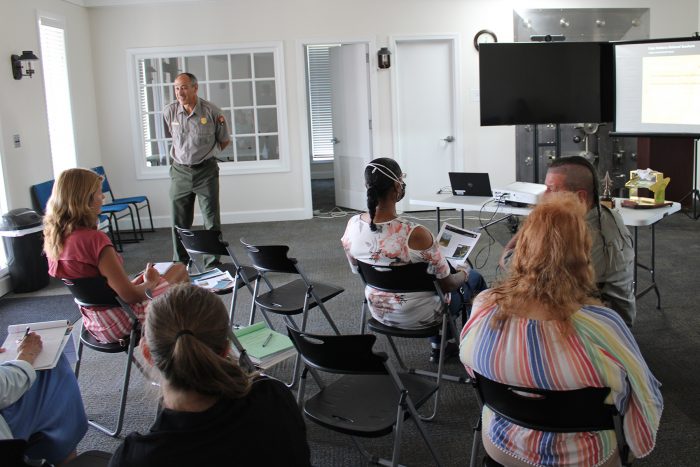
Two upcoming Buxton projects were highlighted at a lightly-attended meeting on Thursday night, June 2, that was hosted by the National Park Service (NPS).
The meeting centered on the Cape Hatteras Lighthouse repair project and the Lighthouse Road pathway project, and was held as part of an ongoing public scoping period, where the public’s input is being sought on the direction of the two endeavors.
Facilitated by David Hallac, National Parks of Eastern North Carolina Superintendent, details were provided on both projects at the meeting, as well as the options and timelines for moving forward.
More information on each of the projects is below.
Lighthouse Road Multi-Use Pathway

In 1984 the Cape Hatteras National Seashore (CHNS) prepared a General Management plan which featured a number of proposed projects in the Buxton area, including a multi-use pathway on Lighthouse Road. Nearly 40 years later, this project is in the early stages of coming to fruition.
Currently, Lighthouse Road – which connects with the Cape Hatteras Lighthouse, Cape Point, and the popular Old Lighthouse Beach – has no sidewalks for cyclists and pedestrians. The proposed multi-use pathway will make this popular stretch of roadway a safer area for the hundreds of thousands of visitors who head to the lighthouse and adjacent beaches every year.
The pathway will be installed in three phases. The first phase covers the stretch from N.C. Highway 12 to the lighthouse, the second phase focuses on the area from the Buxton Beach Day Use Area to the Buxton Lifeguarded Beach, while the third phase covers the stretch of roadway from the lighthouse to the Cape Point campground.
Design work is already underway, thanks to a grant from Cape Hatteras Electric Cooperative and additional financial support from Outer Banks Forever, and three options, (or “preliminary alternatives”), were identified at the meeting as potential plans for the eventual multi-use pathway.
The three alternatives include the following:
- Alternative 1: Construction of a 4’ ft. wide path on each side of Lighthouse Road, as approved in the 1984 General Management Plan.

- Alternative 2: Construction of a separated 8-10’ ft. wide multi-use pathway with a 3-5’ ft. vegetative buffer, which will run parallel to Lighthouse Road.

- Alternative 3: Expand Lighthouse Road to create an 8’ ft. wide bicycle lane on the existing road from N.C. Highway 12 to the Cape Hatteras Lighthouse and Old Lighthouse parking area. There would be no vegetative buffer, and this option was the least desirable for both the NPS and the majority of attendees at Thursday’s meeting.

Regardless of which option is eventually chosen, the cost of the pathway would be $1-$1.5 million per mile, and the NPS is seeking funds for the project from the federal government. “We have a very good chance right now of having a significant amount of funding during the next fiscal year, which starts October 1, to build the one-mile path from the highway to the lighthouse,” said Hallac.
The pathway project is in the very early stages of development, and public feedback on the three options is being accepted until June 22.
“I like to call this the ‘idea generation’ phase,” said Hallac “When this [public comment] period ends in the next three weeks, we’ll start to write the environmental assessment. This will be our formal plan, and we’ll have our preferred alternative in it.”
“Then, we’ll have a public review of the [environmental assessment] – hopefully in early fall – and then in the winter, we’ll make a decision. Following that, if all the stars align, we will begin a contracting process and potentially have this project underway about a year or maybe 18 months from today.”
Comments may be submitted electronically, (the preferred method), or mailed to: Superintendent, 1401 National Park Dr, Manteo, N.C. 27954.
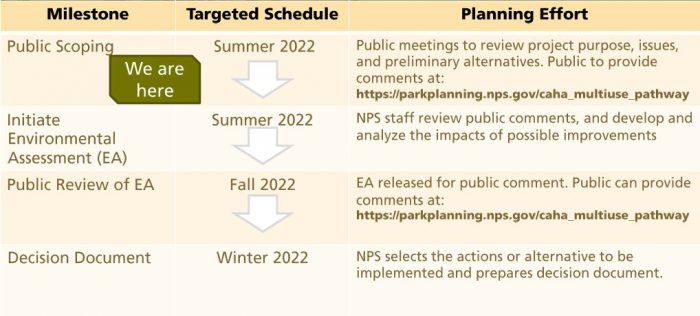
Cape Hatteras Lighthouse Repair and Landscape Improvements Environmental Assessment
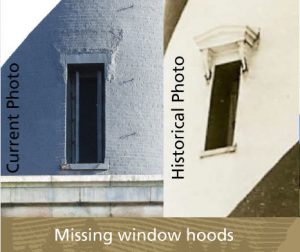
The Cape Hatteras Lighthouse renovation and repair project has been ongoing for several years, as phase one of the project was completed in 2021 when contractors removed the interior paint throughout the lighthouse, stripping the structure to its bare-bones brick interior, and identifying several issues along the way.
“The purpose of the project is to rehabilitate and restore this National Historic Landmark, and its character-defining features,” said Hallac. “What’s a character-defining feature? It’s something that the U.S. government, historical architects, and historians have determined is what makes it historically significant or special.”
“We’re also hoping, throughout the landscape, to provide a more immersive experience for folks that are visiting, and to protect the grounds from the severe erosion that we have.”
“This project is needed because we need to fix all of these interior and exterior features,” added Hallac. “We have peeling paint, broken floor tiles, severely corroded metal – some of which is going to have to be completely removed and replaced – and we also have character-defining features that are missing.”
These missing features include items such as window hoods on the lighthouse itself, as well as the white fence that was originally around the Keeper’s Quarters.
During the course of the project, three alternatives were identified as potential options to move forward, with “Alternative C” being the preferred option by the NPS.
The three alternatives include the following:
- Alternative A: No Action, (which is essentially not being considered)
- Alternative B: Circulation Modified and Lens Restored. Key elements of Alternative B include:
- New circular walkway between Lighthouse and keeper’s quarters.
- “Pull off” areas with interpretive signs.
- Native plantings in strategic areas to encourage use of the new paths.
- New interpretive elements for the lighthouse move and other area resources.
- Restoration and reinstallation of the original Fresnel lens in the Lighthouse.
- Removal of vinyl perimeter fencing around the Lighthouse, and installation of a replica metal octagonal fence.

Landscape improvements under Alternative B. NPS image.
- Alternative C: Circulation improvements are comprehensive, and the lighthouse is rehabilitated and restored. Key elements of Alternative C include:
- New pedestrian loop that connects site features, encouraging visitors to enter the site from a new northern path.
- Contoured landscape with native vegetation to encourage visitors to stay on paths.
- New shade pavilion in the trees to accommodate waiting tour groups.
- New interpretive elements for the lighthouse move and other area resources.
- Production of a replica of the original lens, and installation in the lighthouse as a new light source.
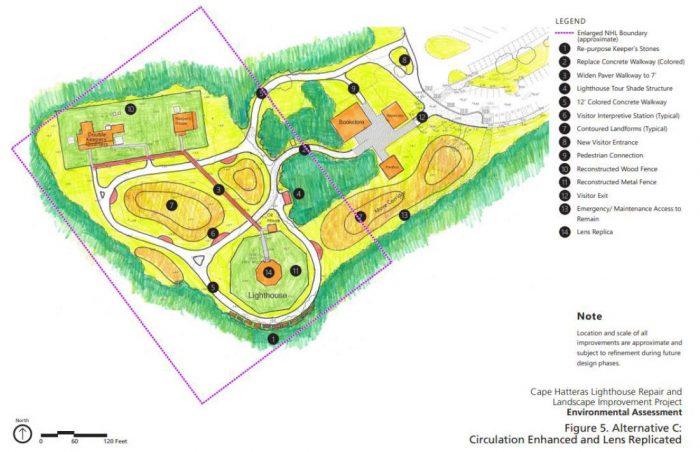
Landscape improvements under Alternative C. NPS image.
The major differences between Alternatives B and C center on the landscape, and the lens itself. In Alternative C, the current 1950s-era beacon will be replaced with a replica First Order Fresnel lens, as opposed to reinstalling the original lens which is currently housed at the Graveyard of the Atlantic Museum in Hatteras.
The new walking paths in Alternative C are also more extensive and expanded than in Alternative B, with the construction of a new shade pavilion to accommodate waiting tour groups. (Landscaping work is an integral part of both options, as after years of foot traffic, the grounds surrounding the lighthouse have severely degraded.)
Regardless of which Alternative is eventually selected, the repair and restoration work to the lighthouse itself will occur.
Currently, the Environmental Assessment has been released to the public for review, and by the end of summer, the NPS will select the alternative to be implemented and start plans for work to begin, hopefully in the winter of 2022/2023. The estimated $18 million cost of the project has already been approved by the U.S. Congress, which occurred several years ago.
As of right now, there is a small chance for seasonal climbing to be available at the Cape Hatteras Lighthouse this summer, although this is unlikely as the interior of the structure remains a work in progress.
The public comment period ends Wednesday, June 22. Comments may be submitted electronically, (the preferred method), or mailed to: Superintendent, 1401 National Park Dr, Manteo, N.C. 27954.
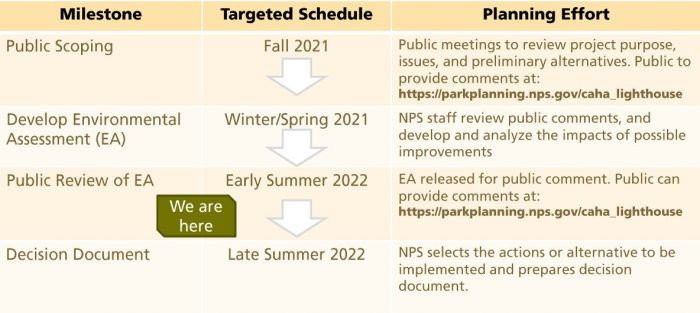
For more information on the multi-use pathway project, click here.
For more information on the Cape Hatteras repairs and landscape improvements project, click here.


